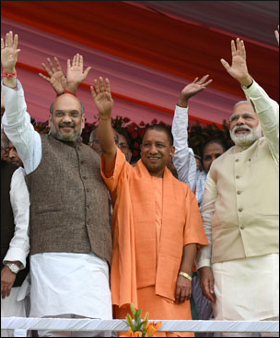|

|
3-years of Modi: Possibility of 2nd innings looms large
|
|

|
|
| Top Stories |
 |
|
|
|
Amulya Ganguli | 20 May, 2017
Considering that the score line in the last round of assembly elections before Narendra Modi's third anniversary of the assumption of power was 3-2 in the Congress's favour, one can only say that his approval rating has been average.
True, the final line-up of winners became 4-1 because the prime minister's factotums were able to dislodge the Congress from its No 1 position in Goa and Manipur with some nimble politicking.
But the fact remains that the supposedly moribund Congress won a handsome victory in Punjab over the Akali Dal-Bharatiya Janata Party (BJP) combine and was initially the largest party in the Goa and Manipur legislatures.
It was the BJP's overwhelming success in Uttar Pradesh which reinforced Modi's larger-than-life image. But the reality is more mundane even if the country has been able to emerge from the policy paralysis of the twilight years of the Manmohan Singh government by achieving a more than seven percent growth rate, up from 5.6 percent in 2012-13 and 6.6 percent in 2013-14.
However, the availability of jobs fell to its lowest level in 2015 and 2016 with figures of 155,000 and 231,000 new jobs compared to one million in 2009, which was Manmohan Singh's best year before Sonia Gandhi's populism undercut the economic reforms.
The reason for the slow job growth is known. It is the increasing resort to automation by the industries. But with 12 million to 15 million new job seekers entering the market every year, India's demographic dividend of having a young work force may become something of a nightmare.
If a recent study nevertheless showed that 60 percent of the respondents thought well of Modi, it meant that a large section of the people have retained their faith in his ability to take the country in the right economic direction.
There may be misgivings about the activities of the saffron militants. But these are probably seen as being isolated incidents which are highlighted by the media and do not affect the average people who are more concerned about the continuing unemployment rate, which has been noted by 63 percent of those surveyed, and inflation (66 percent).
But what has apparently impressed the people the most is the absence of corruption in the higher levels, which was the single most important factor for the Manmohan Singh government's downfall.
However, as the disquiet about unemployment and high prices show, Modi is still basically on shaky ground which has been camouflaged by his rhetoric and the TINA (There Is No Alternative) factor at the national level although he has faced stiff resistance in several states.
The results in Punjab, in the Karnataka by-elections and West Bengal local body polls have shown that it will take a long time, if ever, for the BJP's dream of a Congress-mukt (free) Bharat to be fulfilled.
At the all-India level, however, Modi holds almost complete sway, for none of the other parties has measured up to popular expectations.
The Congress has had to depend on Sonia Gandhi again despite her indifferent health because of Rahul Gandhi's palpable inadequacies; Nitish Kumar has become even more deeply entangled in Bihar's scam-tainted politics; Mulayam Singh Yadav's main battle is still with his son, Akhilesh; Mamata Banerjee has remained essentially a state-level politician in ideas and personal appeal and Naveen Patnaik appears uninterested in the world outside Odisha.
The forthcoming presidential election will be yet another test of the respective strengths of the BJP and its opponents. As of now, the former appears to have its nose ahead in the race, especially because of the expected support from the Telangana Rashtra Samithi and the YSR Congress.
But much will depend on who the BJP chooses as its candidate, for it will show whether the party has risen to its stature after three years in power at the Centre to be a genuine national party or is still beholden to its friend, philosopher and guide -- the Rashtriya Swayamsevak Sangh (RSS) -- for seeing a multicultural nation through saffron-tinted glasses.
In all the appointments to the supposedly autonomous institutions that have been made so far, the BJP has allowed the RSS to plant its standard-bearers, even if the latter are not known for a wide recognition of their talents.
These devoted saffronites include the heads of such well-regarded institutions as the Indian Council of Historical Research and the Indian Council for Social Science Research. It is an open question whether these institutions will retain their high status once their terms end and not be deemed a "circus", as the Nobel prize winner Venkatraman Ramakrishnan called the recent science congress.
But irrespective of who becomes the President -- whether a deeply-hued saffronite or someone perceived as neutral -- the possibility of a second innings for Modi looms large at the end of his three years in office.
His success is based on the image of being a man of development which has remained untainted by the depredations of the gau rakshaks and other Hindu fundamentalists.
(Amulya Ganguli is a political analyst. The views expressed are personal. He can be reached at amulyaganguli@gmail.com)
|
|
|
| |
|
|
|
|
|
|
|
|
|
|
|
|
|
|
| |
| Customs Exchange Rates |
| Currency |
Import |
Export |
US Dollar
|
₹91.25
|
₹89.55 |
UK Pound
|
₹122.85
|
₹118.85 |
Euro
|
₹107.95
|
₹104.3 |
| Japanese
Yen |
₹59 |
₹57.1 |
| As on 29 Dec, 2025 |
|
|
| Daily Poll |
 |
 |
| What is your biggest hurdle to scaling right now? |
|
|
|
|
|
| Commented Stories |
 |
|
|
|
|
|
| |
|